ignition CHRYSLER CARAVAN 2000 Service Manual
[x] Cancel search | Manufacturer: CHRYSLER, Model Year: 2000, Model line: CARAVAN, Model: CHRYSLER CARAVAN 2000Pages: 436, PDF Size: 3.4 MB
Page 5 of 436
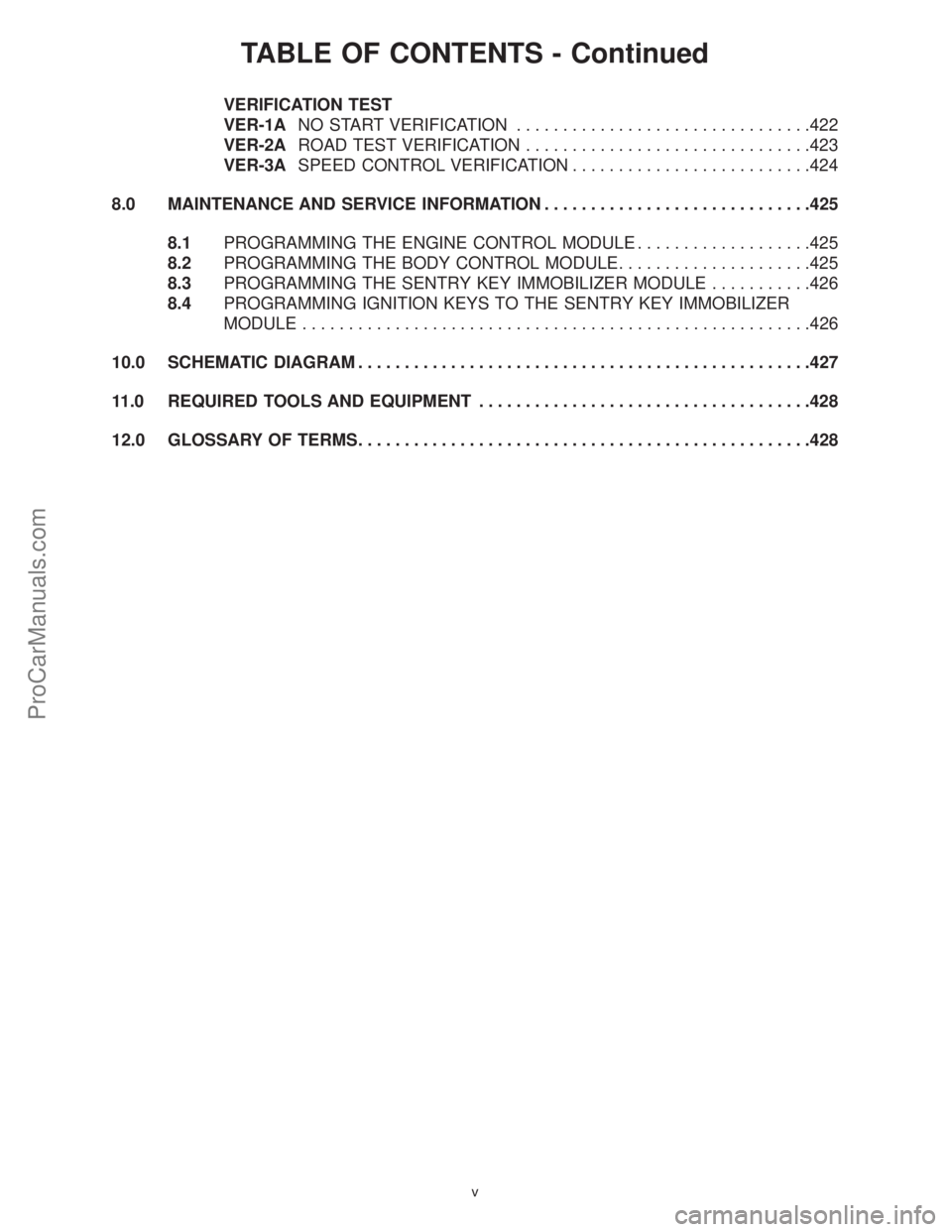
TABLE OF CONTENTS - Continued
VERIFICATION TEST
VER-1ANO START VERIFICATION................................422
VER-2AROAD TEST VERIFICATION...............................423
VER-3ASPEED CONTROL VERIFICATION..........................424
8.0 MAINTENANCE AND SERVICE INFORMATION.............................425
8.1PROGRAMMING THE ENGINE CONTROL MODULE...................425
8.2PROGRAMMING THE BODY CONTROL MODULE.....................425
8.3PROGRAMMING THE SENTRY KEY IMMOBILIZER MODULE...........426
8.4PROGRAMMING IGNITION KEYS TO THE SENTRY KEY IMMOBILIZER
MODULE.......................................................426
10.0 SCHEMATIC DIAGRAM.................................................427
11.0 REQUIRED TOOLS AND EQUIPMENT....................................428
12.0 GLOSSARY OF TERMS.................................................428
v
ProCarManuals.com
Page 8 of 436
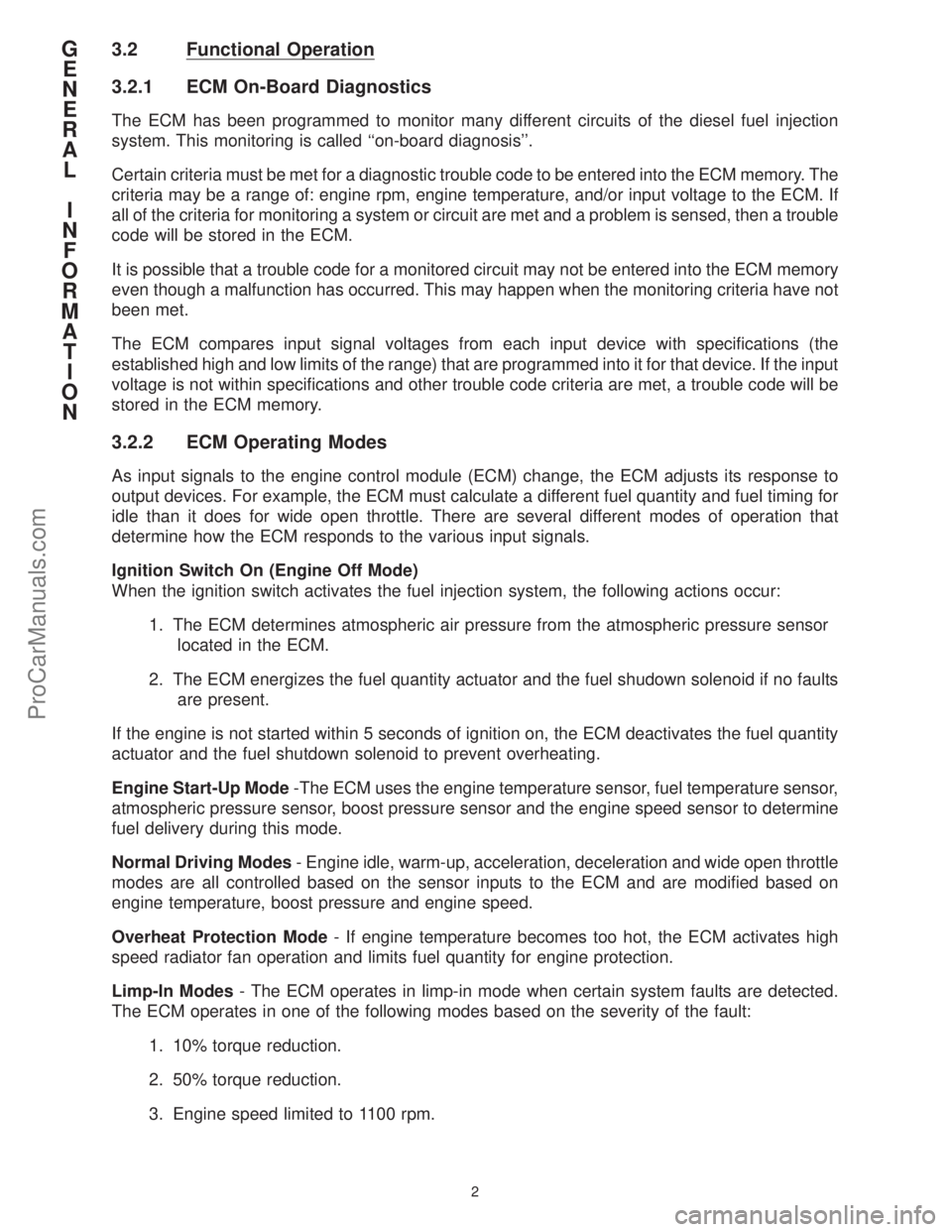
3.2 Functional Operation
3.2.1 ECM On-Board Diagnostics
The ECM has been programmed to monitor many different circuits of the diesel fuel injection
system. This monitoring is called ``on-board diagnosis''.
Certain criteria must be met for a diagnostic trouble code to be entered into the ECM memory. The
criteria may be a range of: engine rpm, engine temperature, and/or input voltage to the ECM. If
all of the criteria for monitoring a system or circuit are met and a problem is sensed, then a trouble
code will be stored in the ECM.
It is possible that a trouble code for a monitored circuit may not be entered into the ECM memory
even though a malfunction has occurred. This may happen when the monitoring criteria have not
been met.
The ECM compares input signal voltages from each input device with specifications (the
established high and low limits of the range) that are programmed into it for that device. If the input
voltage is not within specifications and other trouble code criteria are met, a trouble code will be
stored in the ECM memory.
3.2.2 ECM Operating Modes
As input signals to the engine control module (ECM) change, the ECM adjusts its response to
output devices. For example, the ECM must calculate a different fuel quantity and fuel timing for
idle than it does for wide open throttle. There are several different modes of operation that
determine how the ECM responds to the various input signals.
Ignition Switch On (Engine Off Mode)
When the ignition switch activates the fuel injection system, the following actions occur:
1. The ECM determines atmospheric air pressure from the atmospheric pressure sensor
located in the ECM.
2. The ECM energizes the fuel quantity actuator and the fuel shudown solenoid if no faults
are present.
If the engine is not started within 5 seconds of ignition on, the ECM deactivates the fuel quantity
actuator and the fuel shutdown solenoid to prevent overheating.
Engine Start-Up Mode-The ECM uses the engine temperature sensor, fuel temperature sensor,
atmospheric pressure sensor, boost pressure sensor and the engine speed sensor to determine
fuel delivery during this mode.
Normal Driving Modes- Engine idle, warm-up, acceleration, deceleration and wide open throttle
modes are all controlled based on the sensor inputs to the ECM and are modified based on
engine temperature, boost pressure and engine speed.
Overheat Protection Mode- If engine temperature becomes too hot, the ECM activates high
speed radiator fan operation and limits fuel quantity for engine protection.
Limp-In Modes- The ECM operates in limp-in mode when certain system faults are detected.
The ECM operates in one of the following modes based on the severity of the fault:
1. 10% torque reduction.
2. 50% torque reduction.
3. Engine speed limited to 1100 rpm.
G
E
N
E
R
A
L
I
N
F
O
R
M
A
T
I
O
N
2
ProCarManuals.com
Page 9 of 436

After-Run- When fused ignition switch output is removed from the ECM cavity 47, the ECM
performs a self-diagnostic check in the following order:
1. Electrical shut-off test
2. Fuel quantity actuator test
3. Monitoring module test
4. Voltage regulator test
5. Main relay test (if tests 1-4 pass)
If any of tests 1-4 fail, the fault is stored in memory, and can be retrieved during the next ignition
cycle using the DRB.
3.2.3 Monitored Circuits
The ECM is able to monitor and identify most driveability related trouble conditions. Some circuits
are directly monitored through ECM feedback circuitry. In addition, the ECM monitors the voltage
state of some circuits and compares those states with expected values. Other systems are
monitored indirectly when the ECM conducts a rationality test to identify problems.
Although most subsystems of the powertrain control module are either directly or indirectly
monitored, there may be occasions when diagnostic trouble codes are not immediately identified.
For a trouble code to set, specific conditions must be met and unless these conditions are
encountered, a code will not set.
3.2.4 SKIS On-Board Diagnostics
The SKIS module has been programmed to transmit and monitor many different coded messages
as well as CCD Bus messages. This monitoring is called ``On-Board Diagnosis''.
Certain criteria must be met for a diagnostic trouble code to be entered into the Sentry Key
Immobilizer Module (SKIM) memory. The criteria may be a range of: input voltage, CCD Bus
messages, or coded messages to the SKIM. If all of the criteria for monitoring a circuit or function
are met and a fault is sensed, a diagnostic trouble code will be stored in the SKIM memory.
3.2.5 SKIS Overview
The Sentry Key Immobilizer System (SKIS) is an immobilizer system designed to prevent
unauthorized vehicle operation. The system consists of a Sentry Key Immobilizer Module (SKIM),
ignition key(s) equipped with a transponder chip, engine controller and body controller. When the
ignition switch is turned on, the SKIM interrogates the ignition key. If the ignition key is ªValidº the
SKIM sends a CCD Bus message to the body controller indicating the presence of a valid ignition
key. The BCM then supplies the ECM with a valid immobilizer signal allowing the engine to
continue to operate.
3.2.6 SKIS Operation
When ignition power is supplied to the SKIM, the SKIM performs an internal self-test. After the
self-test is completed, the SKIM energizes the antenna (this activates the transponder chip) and
sends a challenge to the transponder chip. The transponder chip responds to the challenge by
generating an encrypted response message using the following:
Secret Key þ This is an electronically stored value (identification number) that is unique to each
SKIS. The secret key is stored in the SKIM, BCM and all ignition key transponders.
Challenge þ This is a random number that is generated by the SKIM at each ignition key cycle.
G
E
N
E
R
A
L
I
N
F
O
R
M
A
T
I
O
N
3
ProCarManuals.com
Page 10 of 436
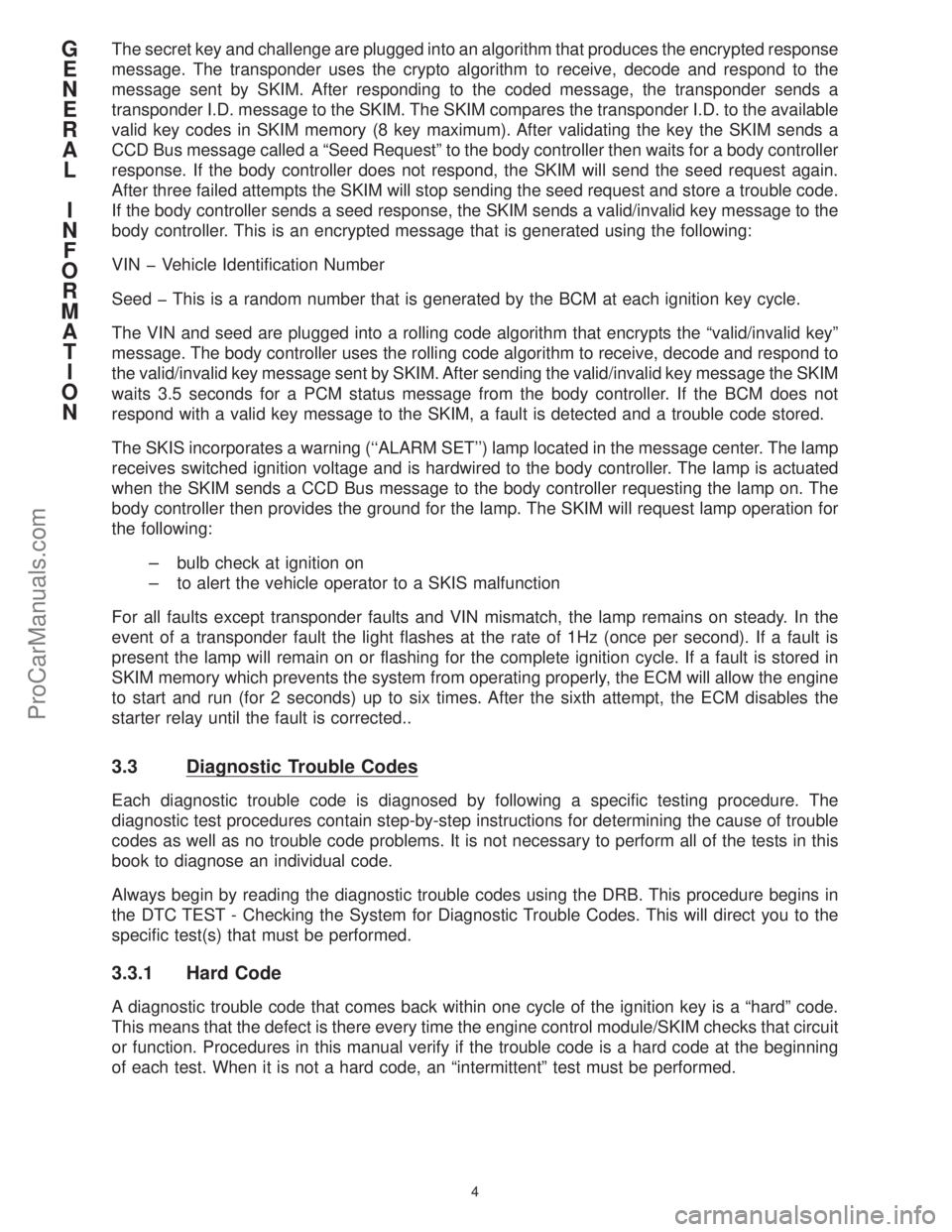
The secret key and challenge are plugged into an algorithm that produces the encrypted response
message. The transponder uses the crypto algorithm to receive, decode and respond to the
message sent by SKIM. After responding to the coded message, the transponder sends a
transponder I.D. message to the SKIM. The SKIM compares the transponder I.D. to the available
valid key codes in SKIM memory (8 key maximum). After validating the key the SKIM sends a
CCD Bus message called a ªSeed Requestº to the body controller then waits for a body controller
response. If the body controller does not respond, the SKIM will send the seed request again.
After three failed attempts the SKIM will stop sending the seed request and store a trouble code.
If the body controller sends a seed response, the SKIM sends a valid/invalid key message to the
body controller. This is an encrypted message that is generated using the following:
VIN þ Vehicle Identification Number
Seed þ This is a random number that is generated by the BCM at each ignition key cycle.
The VIN and seed are plugged into a rolling code algorithm that encrypts the ªvalid/invalid keyº
message. The body controller uses the rolling code algorithm to receive, decode and respond to
the valid/invalid key message sent by SKIM. After sending the valid/invalid key message the SKIM
waits 3.5 seconds for a PCM status message from the body controller. If the BCM does not
respond with a valid key message to the SKIM, a fault is detected and a trouble code stored.
The SKIS incorporates a warning (``ALARM SET'') lamp located in the message center. The lamp
receives switched ignition voltage and is hardwired to the body controller. The lamp is actuated
when the SKIM sends a CCD Bus message to the body controller requesting the lamp on. The
body controller then provides the ground for the lamp. The SKIM will request lamp operation for
the following:
± ± bulb check at ignition on
± to alert the vehicle operator to a SKIS malfunction
For all faults except transponder faults and VIN mismatch, the lamp remains on steady. In the
event of a transponder fault the light flashes at the rate of 1Hz (once per second). If a fault is
present the lamp will remain on or flashing for the complete ignition cycle. If a fault is stored in
SKIM memory which prevents the system from operating properly, the ECM will allow the engine
to start and run (for 2 seconds) up to six times. After the sixth attempt, the ECM disables the
starter relay until the fault is corrected..
3.3 Diagnostic Trouble Codes
Each diagnostic trouble code is diagnosed by following a specific testing procedure. The
diagnostic test procedures contain step-by-step instructions for determining the cause of trouble
codes as well as no trouble code problems. It is not necessary to perform all of the tests in this
book to diagnose an individual code.
Always begin by reading the diagnostic trouble codes using the DRB. This procedure begins in
the DTC TEST - Checking the System for Diagnostic Trouble Codes. This will direct you to the
specific test(s) that must be performed.
3.3.1 Hard Code
A diagnostic trouble code that comes back within one cycle of the ignition key is a ªhardº code.
This means that the defect is there every time the engine control module/SKIM checks that circuit
or function. Procedures in this manual verify if the trouble code is a hard code at the beginning
of each test. When it is not a hard code, an ªintermittentº test must be performed.
G
E
N
E
R
A
L
I
N
F
O
R
M
A
T
I
O
N
4
ProCarManuals.com
Page 11 of 436
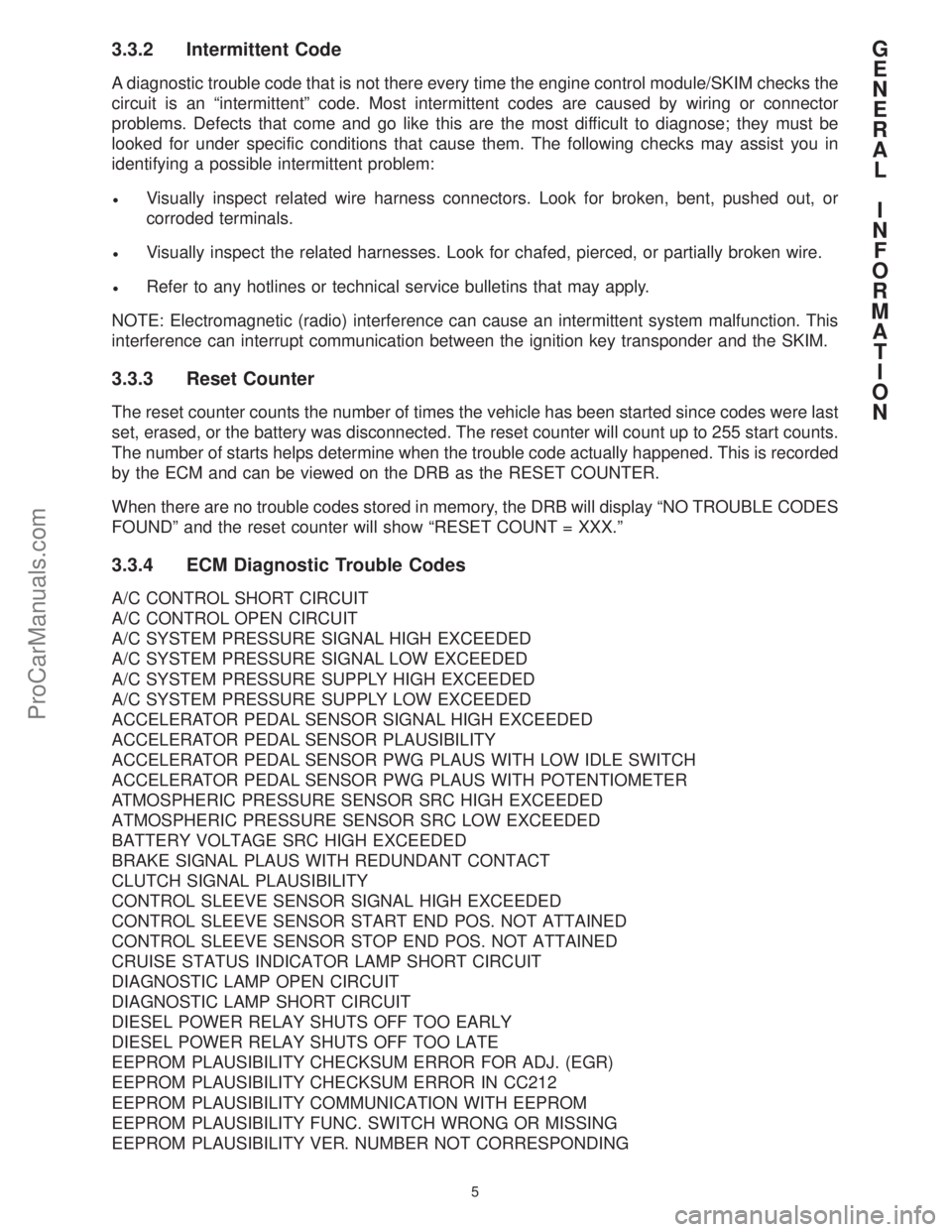
3.3.2 Intermittent Code
A diagnostic trouble code that is not there every time the engine control module/SKIM checks the
circuit is an ªintermittentº code. Most intermittent codes are caused by wiring or connector
problems. Defects that come and go like this are the most difficult to diagnose; they must be
looked for under specific conditions that cause them. The following checks may assist you in
identifying a possible intermittent problem:
²Visually inspect related wire harness connectors. Look for broken, bent, pushed out, or
corroded terminals.
²Visually inspect the related harnesses. Look for chafed, pierced, or partially broken wire.
²Refer to any hotlines or technical service bulletins that may apply.
NOTE: Electromagnetic (radio) interference can cause an intermittent system malfunction. This
interference can interrupt communication between the ignition key transponder and the SKIM.
3.3.3 Reset Counter
The reset counter counts the number of times the vehicle has been started since codes were last
set, erased, or the battery was disconnected. The reset counter will count up to 255 start counts.
The number of starts helps determine when the trouble code actually happened. This is recorded
by the ECM and can be viewed on the DRB as the RESET COUNTER.
When there are no trouble codes stored in memory, the DRB will display ªNO TROUBLE CODES
FOUNDº and the reset counter will show ªRESET COUNT = XXX.º
3.3.4 ECM Diagnostic Trouble Codes
A/C CONTROL SHORT CIRCUIT
A/C CONTROL OPEN CIRCUIT
A/C SYSTEM PRESSURE SIGNAL HIGH EXCEEDED
A/C SYSTEM PRESSURE SIGNAL LOW EXCEEDED
A/C SYSTEM PRESSURE SUPPLY HIGH EXCEEDED
A/C SYSTEM PRESSURE SUPPLY LOW EXCEEDED
ACCELERATOR PEDAL SENSOR SIGNAL HIGH EXCEEDED
ACCELERATOR PEDAL SENSOR PLAUSIBILITY
ACCELERATOR PEDAL SENSOR PWG PLAUS WITH LOW IDLE SWITCH
ACCELERATOR PEDAL SENSOR PWG PLAUS WITH POTENTIOMETER
ATMOSPHERIC PRESSURE SENSOR SRC HIGH EXCEEDED
ATMOSPHERIC PRESSURE SENSOR SRC LOW EXCEEDED
BATTERY VOLTAGE SRC HIGH EXCEEDED
BRAKE SIGNAL PLAUS WITH REDUNDANT CONTACT
CLUTCH SIGNAL PLAUSIBILITY
CONTROL SLEEVE SENSOR SIGNAL HIGH EXCEEDED
CONTROL SLEEVE SENSOR START END POS. NOT ATTAINED
CONTROL SLEEVE SENSOR STOP END POS. NOT ATTAINED
CRUISE STATUS INDICATOR LAMP SHORT CIRCUIT
DIAGNOSTIC LAMP OPEN CIRCUIT
DIAGNOSTIC LAMP SHORT CIRCUIT
DIESEL POWER RELAY SHUTS OFF TOO EARLY
DIESEL POWER RELAY SHUTS OFF TOO LATE
EEPROM PLAUSIBILITY CHECKSUM ERROR FOR ADJ. (EGR)
EEPROM PLAUSIBILITY CHECKSUM ERROR IN CC212
EEPROM PLAUSIBILITY COMMUNICATION WITH EEPROM
EEPROM PLAUSIBILITY FUNC. SWITCH WRONG OR MISSING
EEPROM PLAUSIBILITY VER. NUMBER NOT CORRESPONDING
G
E
N
E
R
A
L
I
N
F
O
R
M
A
T
I
O
N
5
ProCarManuals.com
Page 15 of 436
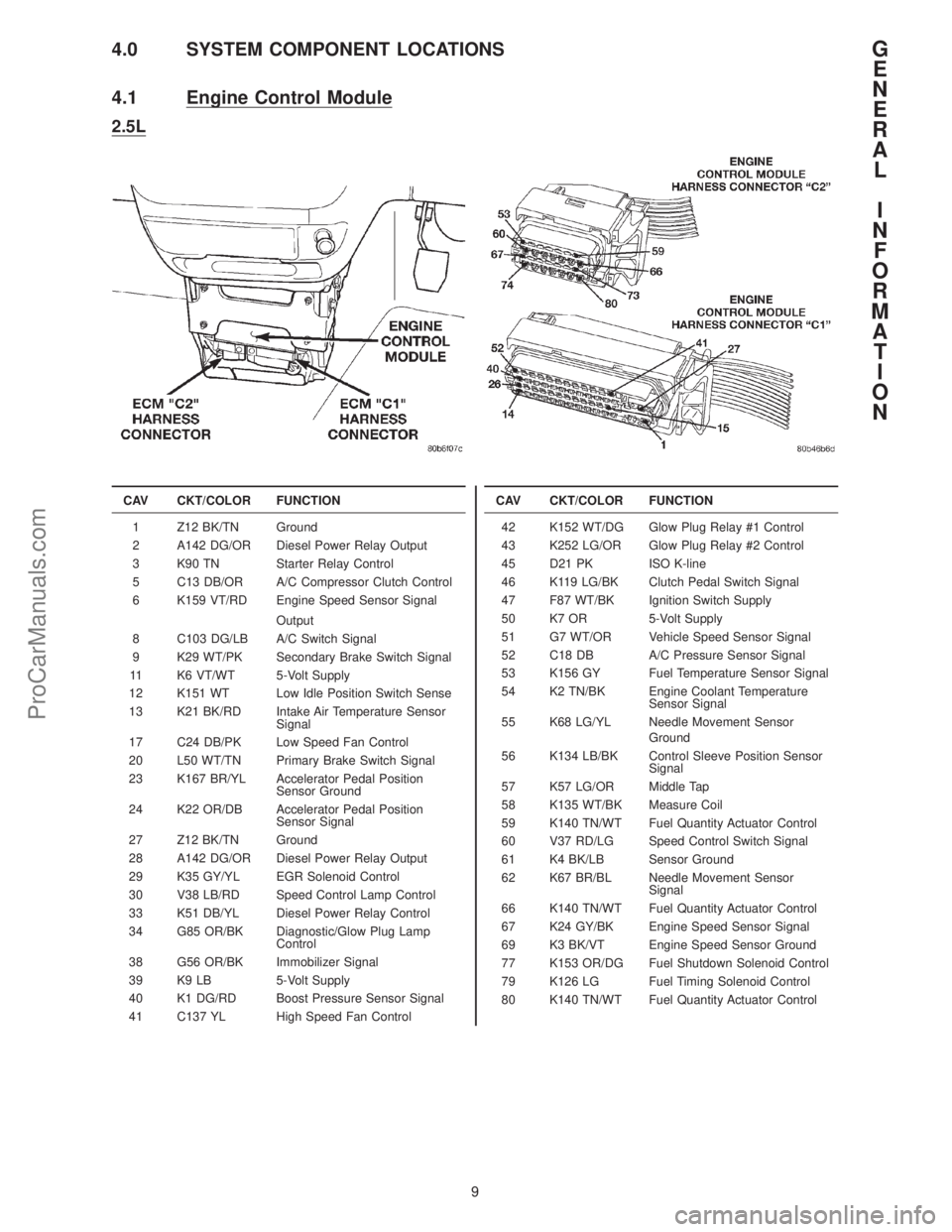
4.0 SYSTEM COMPONENT LOCATIONS
4.1 Engine Control Module
2.5L
CAV CKT/COLOR FUNCTION
1 Z12 BK/TN Ground
2 A142 DG/OR Diesel Power Relay Output
3 K90 TN Starter Relay Control
5 C13 DB/OR A/C Compressor Clutch Control
6 K159 VT/RD Engine Speed Sensor Signal
Output
8 C103 DG/LB A/C Switch Signal
9 K29 WT/PK Secondary Brake Switch Signal
11 K6 VT/WT 5-Volt Supply
12 K151 WT Low Idle Position Switch Sense
13 K21 BK/RD Intake Air Temperature Sensor
Signal
17 C24 DB/PK Low Speed Fan Control
20 L50 WT/TN Primary Brake Switch Signal
23 K167 BR/YL Accelerator Pedal Position
Sensor Ground
24 K22 OR/DB Accelerator Pedal Position
Sensor Signal
27 Z12 BK/TN Ground
28 A142 DG/OR Diesel Power Relay Output
29 K35 GY/YL EGR Solenoid Control
30 V38 LB/RD Speed Control Lamp Control
33 K51 DB/YL Diesel Power Relay Control
34 G85 OR/BK Diagnostic/Glow Plug Lamp
Control
38 G56 OR/BK Immobilizer Signal
39 K9 LB 5-Volt Supply
40 K1 DG/RD Boost Pressure Sensor Signal
41 C137 YL High Speed Fan ControlCAV CKT/COLOR FUNCTION
42 K152 WT/DG Glow Plug Relay #1 Control
43 K252 LG/OR Glow Plug Relay #2 Control
45 D21 PK ISO K-line
46 K119 LG/BK Clutch Pedal Switch Signal
47 F87 WT/BK Ignition Switch Supply
50 K7 OR 5-Volt Supply
51 G7 WT/OR Vehicle Speed Sensor Signal
52 C18 DB A/C Pressure Sensor Signal
53 K156 GY Fuel Temperature Sensor Signal
54 K2 TN/BK Engine Coolant Temperature
Sensor Signal
55 K68 LG/YL Needle Movement Sensor
Ground
56 K134 LB/BK Control Sleeve Position Sensor
Signal
57 K57 LG/OR Middle Tap
58 K135 WT/BK Measure Coil
59 K140 TN/WT Fuel Quantity Actuator Control
60 V37 RD/LG Speed Control Switch Signal
61 K4 BK/LB Sensor Ground
62 K67 BR/BL Needle Movement Sensor
Signal
66 K140 TN/WT Fuel Quantity Actuator Control
67 K24 GY/BK Engine Speed Sensor Signal
69 K3 BK/VT Engine Speed Sensor Ground
77 K153 OR/DG Fuel Shutdown Solenoid Control
79 K126 LG Fuel Timing Solenoid Control
80 K140 TN/WT Fuel Quantity Actuator Control
G
E
N
E
R
A
L
I
N
F
O
R
M
A
T
I
O
N
9
ProCarManuals.com
Page 24 of 436

²Choose the proper range and function for the measurement. Do not try voltage or current
measurements that may exceed the rated capacity.
²Do not exceed the limits shown in the table below:
FUNCTION INPUT LIMIT
Volts 0 - 500 peak volts AC
0 - 500 volts DC
Ohms (resistance)* 0 - 1.12 megohms
Frequency Measured
Frequency Generated0-10kHz
Temperature -58 - 1100É F
-50 - 600É C
* Ohms cannot be measured if voltage is
present. Ohms can be measured only in a
non-powered circuit.
²Voltage between any terminal and ground must not exceed 500v DC or 500v peak AC.
²Use caution when measuring voltage above 25v DC or 25v AC.
²The circuit being tested must be protected by a 10A fuse or circuit breaker.
²Use the low current shunt to measure circuits up to 10A. Use the high current clamp to
measure circuits exceeding 10A.
²When testing for the presence of voltage or current, make sure the meter is functioning
correctly. Take a reading of a known voltage or current before accepting a zero reading.
²When measuring current, connect the meter in series with the load.
²Disconnect the live test lead before disconnecting the common test lead.
5.3 Warnings
5.3.1 Vehicle Damage Warnings
Before disconnecting any control module, make sure the ignition is ``off''. Failure to do so could
damage the module.
When testing voltage or continuity at any control module, use the terminal side (not the wire end)
of the connector. Do not probe a wire through the insulation; this will damage it and eventually
cause it to fail because of corrosion.
Be careful when performing electrical tests so as to prevent accidental shorting of terminals. Such
mistakes can damage fuses or components. Also, other codes could be set, making diagnosis of
the original problem more difficult.
5.3.2 Road Testing a Complaint Vehicle
Some complaints will require a test drive as part of the repair verification procedure. The purpose
of the test drive is to try to duplicate the diagnostic code or symptom condition.
CAUTION: Before road testing a vehicle, be sure that all components are reassembled.
During the test drive, do not try to read the DRB screen while in motion. Do not hang the
DRB from the rear view mirror or operate it yourself. Have an assistant available to operate
the DRB.
G
E
N
E
R
A
L
I
N
F
O
R
M
A
T
I
O
N
18
ProCarManuals.com
Page 27 of 436

TEST DTCCHECKING FOR DIAGNOSTIC TROUBLE CODES
DRBIIITDIAGNOSTIC TROUBLE CODE (DTC) DISPLAYEDDIAGNOSTIC
TESTSCAN
TOOL
Engine Speed Sensor Over Speed Recognition TC-36 P0725
Engine Speed Sensor Static Plausibility TC-38 P0725
Fan Control Open Circuit Fan #1TC-39 P1690
Fan Control Open Circuit Fan #2TC-40 P1690
Fan Control Short Circuit Fan #1TC-41 P1690
Fan Control Short Circuit Fan #2TC-42 P1690
Fuel Quantity Actuator Neg. Gov. Deviation Cold TC-43 P1220
Fuel Quantity Actuator Neg. Gov. Deviation Warm TC-44 P1220
Fuel Quantity Actuator Pos. Gov. Deviation Cold TC-45 P1220
Fuel Quantity Actuator Pos. Gov. Deviation Warm TC-46 P1220
Fuel Temperature Sensor SRC High Exceeded TC-47 P0180
Fuel Temperature Sensor SRC Low Exceeded TC-48 P0180
Glow Relay #1 Controller Open Circuit TC-51 P1635
Glow Relay #2 Controller Open Circuit TC-52 P1635
Glow Relay #1 Controller Short Circuit TC-53 P1635
Glow Relay #2 Controller Short Circuit TC-54 P1635
Inductive Aux. Speed Sensor Dynamic Plausibility TC-56 P1725
Inductive Aux. Speed Sensor Overspeed Recognition TC-57 P1725
Inductive Aux. Speed Sensor Plausibility TC-58 P1725
Inductive Aux. Speed Sensor Static Plausibility TC-59 P1725
Intake Air Temperature Sensor Signal High Exceeded TC-62 P0110
Intake Air Temperature Sensor Signal Low Exceeded TC-63 P0110
Microcontroller Gate-array Monitoring** P1615
Microcontroller Gate-array Watchdog** P1615
Microcontroller Prepare Fuel Quantity Stop ** P1615
Microcontroller Recovery Has Occurred ** P1615
Microcontroller Redundant Overrun Monitoring ** P1615
Needle Movement Sensor High Exceeded TC-72 P1201
Needle Movement Sensor Low Exceeded TC-73 P1201
Redundant Emer. Stop Plausibility in After-run TC-74 P1660
Redundant Emer. Stop Powerstate Defective TC-75 P1660
Regulator Lower Regulator Limit** P1610
Regulator Upper Regulator Limit** P1610
Smart Start Relay Short CircuitTC-76 P1675
Solenoid Valve Controller Open Circuit TC-79 P1630
Solenoid Valve Controller Short Circuit TC-80 P1630
Temperature of Engine Coolant SRC High Exceeded TC-81 P0115
Temperature of Engine Coolant SRC Low Exceeded TC-82 P0115
Terminal #15 Plausibility After Start-up TC-84 P1605
Timing Governing Negative Governor Deviation TC-85 P1230
Timing Governing Positive Governor Deviation TC-86 P1230
UþREF (2.5V)** P1620
Vehicle Speed Sensor Pec Frequency Too High TC-91 P0500
Vehicle Speed Sensor Signal High Exceeded TC-91 P0500
Vehicle Speed Sensor PlausibilityTC-91 P0500
Immobilizer Signal LostTC-94 P1685
Invalid SKIM MessageTC-94 P1685
** These trouble codes indicate an internal ECM fault. Using the DRB, clear ECM trouble code(s).
Perform several engine run cycles turning the ignition off for at least 10 seconds between cycles.
Using the DRB, read ECM trouble codes. If the code is present, replace the Engine Control Module.
NOTE: If trouble code TERMINAL 15 PLAUSIBILITY AFTER START-UP is present with other trouble
codes, perform TC-84 diagnosis first.
T
R
O
U
B
L
E
C
O
D
E
T
E
S
T
S
21
ProCarManuals.com
Page 31 of 436

TEST TC-1ACONTINUED - REPAIRING - A/C CONTROL SHORT CIRCUIT
*Perform Verification TEST VER-2A. **Check connectors - Clean / repair as necessary.
TEST TC-1A TURN IGNITION ON.
CONTINUED FROM IS THE A/C CLUTCH NO CONTINUE TEST
THE PREVIOUS WITH THE DRB, RELAY CLICKING? TC-1A ON THE
PAGE. ACTUATE THE A/C NEXT PAGE.
CLUTCH RELAY.
YES
THE CONDITION TO SET USING THE SCHEMATIC
THE TROUBLE CODE IS AS A GUIDE, INSPECT WERE ANY PROBLEMS YES REPAIR AS
NOT PRESENT. THE WIRING AND FOUND? NECESSARY.*
CONNECTORS.
FIG.1 FIG.2
NO
WIGGLE THE WIRING NOTE: THE DRB MUST REPAIR AS
HARNESS FROM THE STILL BE ACTUATING DID THE WIGGLING YES NECESSARY WHERE
RELAY TO THE THE A/C CLUTCH INTERRUPT THE WIGGLING CAUSED
ENGINE CONTROL RELAY. CLICKING? CLICKING TO BE
MODULE.INTERRUPTED.*
NO
REFER TO GENERAL
INFORMATION 3.3.2 YES
FOR ADDITIONAL TEST COMPLETED.*
INFORMATION ON
INTERMITTENT CODES.
T
R
O
U
B
L
E
C
O
D
E
T
E
S
T
S
25
ProCarManuals.com
Page 33 of 436

TEST TC-1ACONTINUED - REPAIRING - A/C CONTROL SHORT CIRCUIT
*Perform Verification TEST VER-2A. **Check connectors - Clean / repair as necessary.
TEST TC-1A
CONTINUED FROM TURN IGNITION OFF.
THE PREVIOUS REMOVE THE A/C
PAGE. CLUTCH RELAY.**
USING AN OHMMETER, 85 AND 86 IS THE RESISTANCE
MEASURE RESISTANCE 85 AND 87 BELOW 30.0 OHMS YES REPLACE THE A/C
BETWEEN A/C CLUTCH 85 AND 30 FOR ANY OF THE CLUTCH RELAY.*
RELAY TERMINALS... 85 AND 87A MEASUREMENTS?
FIG.2
NO
DISCONNECT THE ECM REMOVE THE DIESEL
HARNESS POWER RELAY.**
CONNECTORS.**
WITH A JUMPER WIRE, TURN IGNITION ON.
CONNECT DIESEL POWER
RELAY CONN. CAVITIES USE A VOLTMETER IN
30 AND 87 (IN PDC). THE FOLLOWING
FIG.3 STEP.
MEASURE THE RELAYREPAIR A/C CLUTCH
CONTROL CIRCUIT AT IS THE VOLTAGE YES RELAY CONTROL
RELAY CONNECTOR ABOVE 1.0 VOLT? CIRCUIT FOR SHORT
(IN PDC).TO VOLTAGE.*
FIG.1
NO
REPLACE THE ENGINE
CONTROL MODULE.*
T
R
O
U
B
L
E
C
O
D
E
T
E
S
T
S
27
ProCarManuals.com